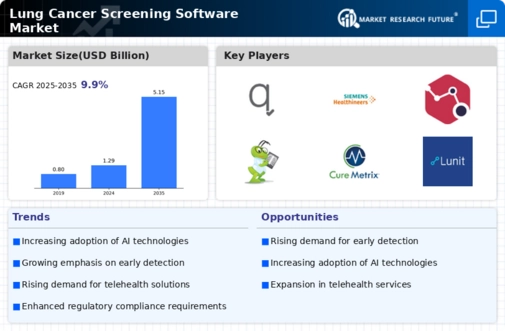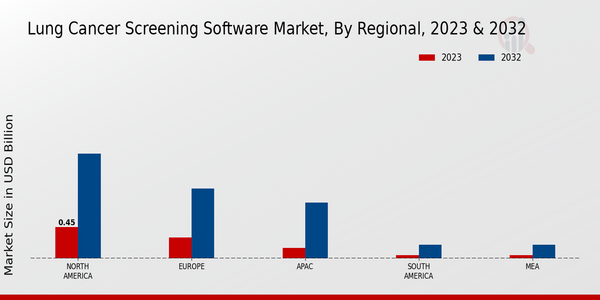Market Growth Projections
The Global Lung Cancer Screening Software Market Industry is projected to experience substantial growth over the next decade. With an estimated market value of 1.29 USD Billion in 2024, it is anticipated to reach 5.15 USD Billion by 2035. This growth trajectory suggests a compound annual growth rate (CAGR) of 13.42% from 2025 to 2035. Such projections indicate a robust demand for innovative screening solutions, driven by factors such as technological advancements, increasing lung cancer incidence, and heightened awareness of preventive healthcare. The market's expansion reflects the critical need for effective lung cancer screening tools in the global healthcare landscape.
Rising Incidence of Lung Cancer
The increasing incidence of lung cancer globally serves as a primary driver for the Global Lung Cancer Screening Software Market Industry. According to health statistics, lung cancer remains one of the most prevalent cancers, with millions diagnosed each year. This alarming trend underscores the necessity for early detection and effective screening solutions. As healthcare systems strive to improve patient outcomes, the demand for advanced screening software that can facilitate timely diagnosis is likely to surge. The industry's growth is further propelled by the need for innovative technologies that enhance the accuracy and efficiency of lung cancer detection.
Government Initiatives and Funding
Government initiatives aimed at combating lung cancer play a crucial role in driving the Global Lung Cancer Screening Software Market Industry. Many countries are implementing screening programs and allocating funds to enhance early detection efforts. These initiatives often include public awareness campaigns that educate populations about the importance of screening. Additionally, government support for research and development in lung cancer technologies fosters innovation within the industry. Such funding not only encourages the development of advanced screening software but also ensures that healthcare providers have access to the necessary tools to improve patient outcomes.
Integration of Telehealth Services
The integration of telehealth services into healthcare systems is emerging as a vital driver for the Global Lung Cancer Screening Software Market Industry. Telehealth facilitates remote consultations and monitoring, making lung cancer screening more accessible to patients, particularly in underserved areas. This shift towards digital health solutions is likely to enhance patient engagement and adherence to screening protocols. As healthcare providers increasingly adopt telehealth platforms, the demand for compatible screening software is expected to rise. This trend not only supports the growth of the market but also aligns with the broader movement towards more patient-centered healthcare delivery.
Growing Awareness of Preventive Healthcare
The growing awareness of preventive healthcare among the global population is a significant driver for the Global Lung Cancer Screening Software Market Industry. As individuals become more informed about the benefits of early detection, there is an increasing demand for screening services. This shift in mindset encourages healthcare providers to adopt advanced screening software that can facilitate timely and accurate diagnoses. Furthermore, educational campaigns and community outreach programs are likely to enhance public understanding of lung cancer risks, thereby increasing the utilization of screening services. This trend is expected to contribute to the overall growth of the market.
Technological Advancements in Screening Tools
Technological advancements in imaging and diagnostic tools significantly influence the Global Lung Cancer Screening Software Market Industry. Innovations such as artificial intelligence and machine learning are being integrated into screening software, enhancing the precision of lung cancer detection. These technologies enable healthcare providers to analyze imaging data more effectively, leading to earlier diagnosis and better patient management. As the software becomes more sophisticated, it is expected to attract a larger share of the market, potentially contributing to the projected growth from 1.29 USD Billion in 2024 to 5.15 USD Billion by 2035, with a CAGR of 13.42% from 2025 to 2035.











